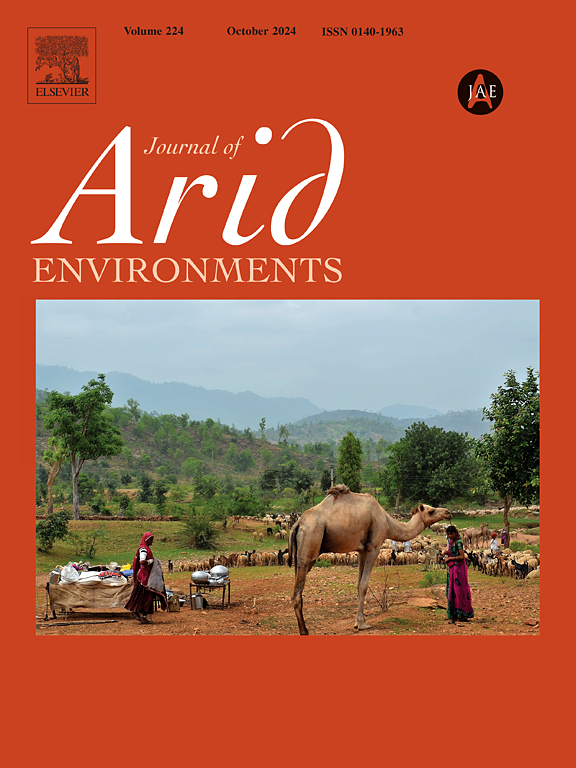The impact of browsing intensity on argan trees in the Essaouira region of Morocco
IF 2.5
3区 环境科学与生态学
Q2 ECOLOGY
引用次数: 0
Abstract
Pastoralism is a cornerstone of the argan forest ecosystem in Morocco, where the argan tree supports food production and livelihoods. However, overbrowsing threatens this ecosystem, underscoring the need for sustainable management strategies. This study assessed the impact of three browsing intensities on argan trees in the Essaouira region: no-browsing, moderate-browsing (managed browsing or the Agdal system), and heavy-browsing systems. Measurements of argan physiological and biochemical traits and soil parameters revealed significant differences among the three-browsing intensities. Heavily browsed argan trees exhibited reduced photosynthetic efficiency, stomatal conductance, photosynthetic pigments content, and leaf area index, while no-browsing system maintained optimal performances. The Agdal strategy significantly enhanced plant health compared to heavy browsing, improving physiological indicators and soil quality. Soil traits including electrical conductivity, moisture, and organic matter and total nitrogen content were notably better under managed browsing, promoting healthier argan ecosystems. Additionally, browsing intensity affected leaf biochemistry: overbrowsing induced a decline in protein content, while it enhanced total soluble sugars, malondialdehyde, and hydrogen peroxide content, and antioxidant enzymes activity (catalase, peroxidase, and polyphenoloxidase), reflecting heightened stress responses. Overall, even if the non-browsed trees performed best, the moderate-browsing system (Agdal) may be the most suitable of the three browsing systems, since it will be able to meet goats’ feed needs while ensuring the sustainability of the argan forest ecosystem.
浏览强度对摩洛哥索维拉地区摩洛哥坚果树的影响
畜牧业是摩洛哥摩洛哥坚果森林生态系统的基石,摩洛哥坚果树支持着粮食生产和生计。然而,过度浏览威胁着这一生态系统,强调了可持续管理战略的必要性。本研究评估了三种浏览强度对索维拉地区摩洛哥坚果树的影响:无浏览、中度浏览(管理浏览或Agdal系统)和重度浏览系统。结果表明,在不同的浏览强度下,摩洛哥坚果的生理生化特性和土壤参数存在显著差异。重度浏览的坚果树的光合效率、气孔导度、光合色素含量和叶面积指数均较低,而无浏览的坚果树表现最佳。与重度浏览相比,Agdal策略显著提高了植物健康,改善了生理指标和土壤质量。土壤电导率、水分、有机质和全氮含量等性状在管理浏览下显著改善,促进了有机有机质生态系统的健康。此外,浏览强度还影响叶片生物化学:过度浏览导致蛋白质含量下降,而总可溶性糖、丙二醛和过氧化氢含量增加,抗氧化酶(过氧化氢酶、过氧化物酶和多酚氧化酶)活性增加,反映出应激反应增强。总体而言,即使非浏览树木表现最好,中等浏览系统(Agdal)可能是三种浏览系统中最合适的,因为它将能够满足山羊的饲料需求,同时确保有机坚果林生态系统的可持续性。
本文章由计算机程序翻译,如有差异,请以英文原文为准。
求助全文
约1分钟内获得全文
求助全文
来源期刊

Journal of Arid Environments
环境科学-环境科学
CiteScore
5.70
自引率
3.70%
发文量
144
审稿时长
55 days
期刊介绍:
The Journal of Arid Environments is an international journal publishing original scientific and technical research articles on physical, biological and cultural aspects of arid, semi-arid, and desert environments. As a forum of multi-disciplinary and interdisciplinary dialogue it addresses research on all aspects of arid environments and their past, present and future use.
 求助内容:
求助内容: 应助结果提醒方式:
应助结果提醒方式:


